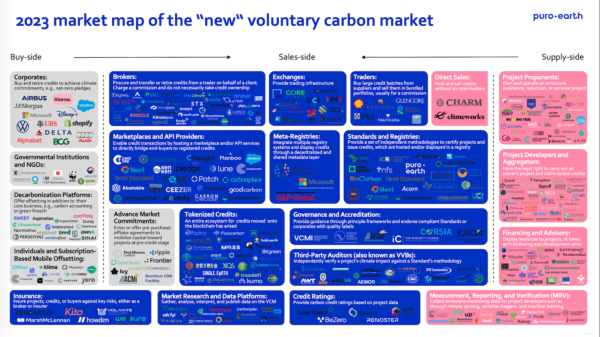By Joey O’Brien
Is the carbon market real? Take a look at this map identifying current actors in the voluntary carbon market.
If you have not been inundated with information about carbon credits or offsets, you might have found the perfect rock to hide under. But for the rest of us, let’s clear up some of the confusion. A carbon tax is a fine for using the atmosphere like a dump. We pay our local waste commission to dispose of some of our garbage, but until now the atmosphere has been a free dump.
There is a HUGE amount of misinformation spread by various media outlets about the voracity of carbon credits and or offsets. Much of it comes from nefarious efforts by carbon-producing industries to protect the status quo. Starting in 2-3 years it won’t really matter whether nations have a national carbon market, as our international banking and insurance industries will make reporting on environment, sustainability and governance (ESG) mandatory.
Carbon taxes won a Nobel Prize as the most efficient way to reduce carbon emissions. Many national, regional, and local governments have planned escalating carbon taxes.
In Canada we are at $50/ton now, and will go up $15/ton each year until we reach $170/ton by 2030. I completed several grant applications in 2022, and the funders were very specific in asking applicants to measure the proposed action against the federal government’s 2030, 2040, and 2050 climate action goals.
To diminish the economic impact of carbon taxes, and to incentivize citizens, corporations and governments to take action to decrease their carbon footprint, a number of options have been developed, including returning funds to citizens and making grants and loans for corporations for taking specific actions to decrease their carbon footprint.
Some provinces and other jurisdictions are treating this shift as an opportunity to create the businesses of the next decades. There are provinces that are targeting carbon neutrality by 2030 and leveraging this to attract industry to accomplish this. In the US the Inflation Reduction Act of 2022 has generated over 100,000 new green energy jobs in five months.
We must reduce our emissions as soon as possible. We are already at 420 parts per million and increasing by 2-3 PPM per year. So we must stop filling the atmosphere like a dump and then actively work at reducing the carbon levels back to 350 PPM or less. This must occur by 2050. Failure to accomplish this will fulfill all the fears we have for our children and grandchildren.
How can a Rotary club help accomplish this?
ESRAG’s 2020-21 Chair and past Projects Chair, Chris Puttock, estimates that Rotary clubs are conducting upwards to 50,000 projects at any time. A large percentage of these would suck carbon from the atmosphere and/or generate clean energy that offsets higher carbon energy from the grid. At ESRAG we are working on developing a framework for measuring and monetizing projects that meet the carbon reduction goals. Stay tuned as we build this out. We want to reward clubs with real funds for their work.
Start out with knowledge. Learn about your jurisdiction’s rules. Work at influencing climate action.
Joey O’Brien is President of the consulting firm SustainDriven and an ESRAG Director. He is a member of the Rotary Club of Canmore in Alberta, Canada. See his story, this issue, on how to build sustainability into major sports events.

